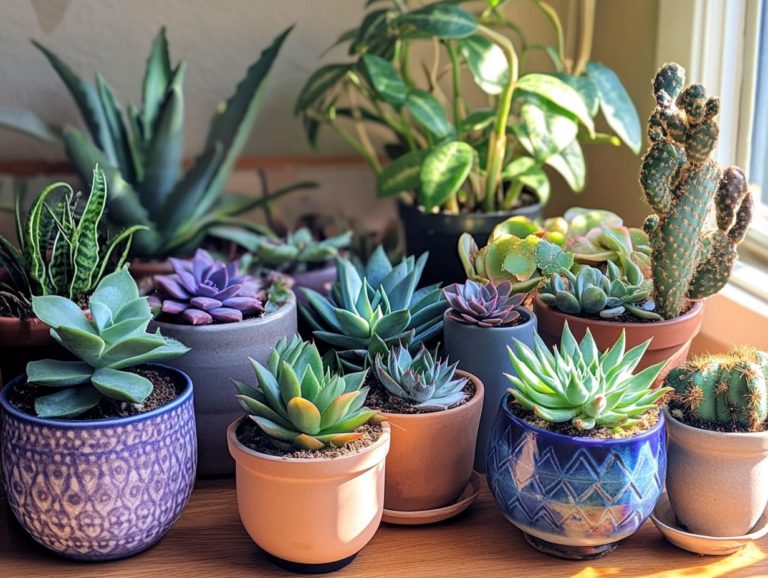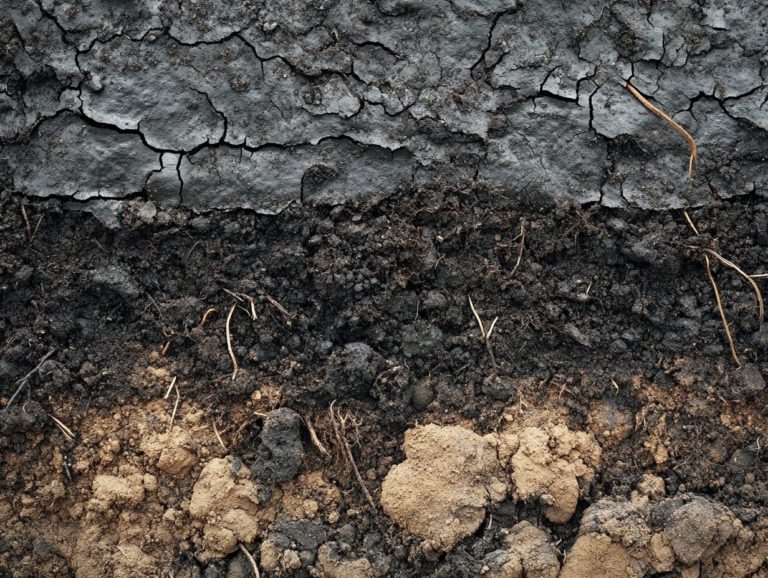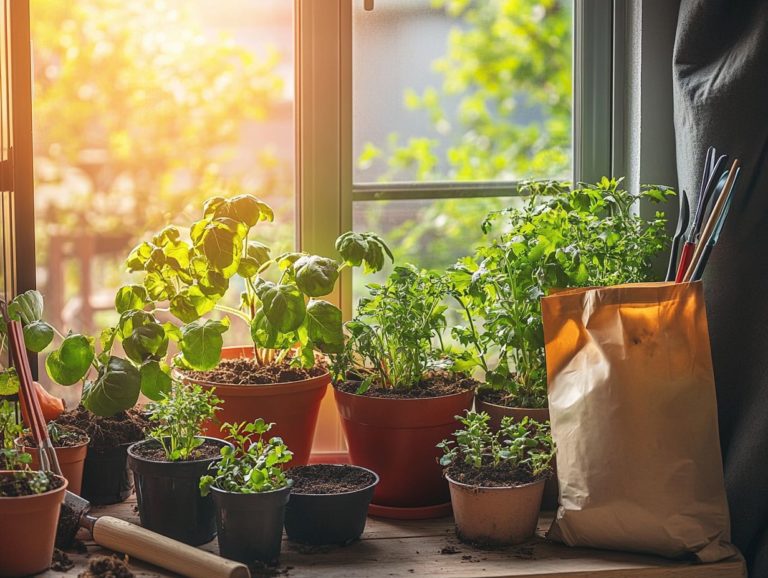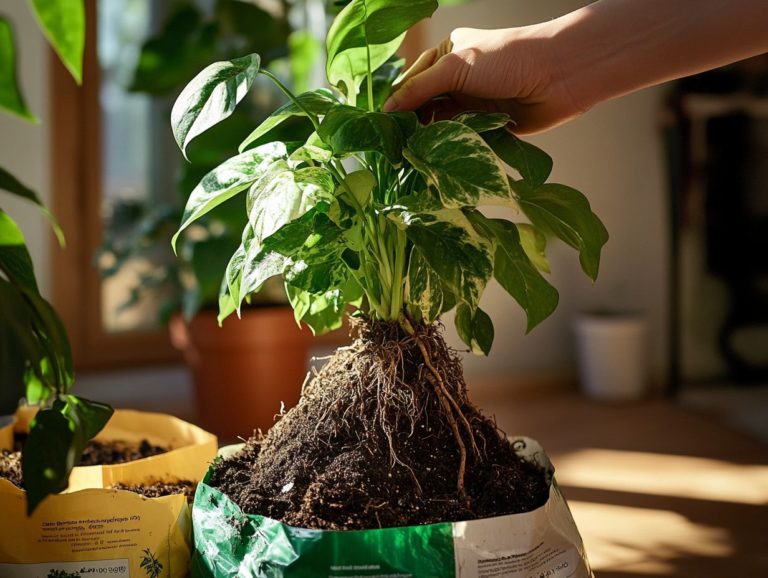How to Properly Water Indoor Plants in Soil
Indoor plants have the power to infuse vitality and vibrancy into your space. However, their well-being relies heavily on one essential aspect: proper watering and maintaining high water quality.
Grasping how to cater to your plants’ unique hydration requirements is vital for their flourishing. This article delves into effective watering techniques, identifies signs of both underwatering and overwatering, and examines various factors that influence watering needs.
Discover best practices, steer clear of common missteps, and access troubleshooting tips to ensure your leafy companions not only survive but thrive. Dive in to unveil the secrets of successful indoor gardening!
Contents
- Key Takeaways:
- Understanding Indoor Plant Watering
- Signs of Underwatering and Overwatering
- Factors Affecting Watering Needs
- Best Practices for Watering Indoor Plants
- Common Mistakes to Avoid
- Troubleshooting Watering Issues
- Your Top Questions About Indoor Plant Care
- 1. How often should I water my indoor plants in soil?
- 2. How do I know if my indoor plant needs watering?
- 3. Should I water my indoor plants in soil from the top or bottom?
- 4. Can I use tap water to water my indoor plants in soil?
- 5. How much water should I give my indoor plants in soil?
- 6. Can I overwater my indoor plants in soil?
Key Takeaways:
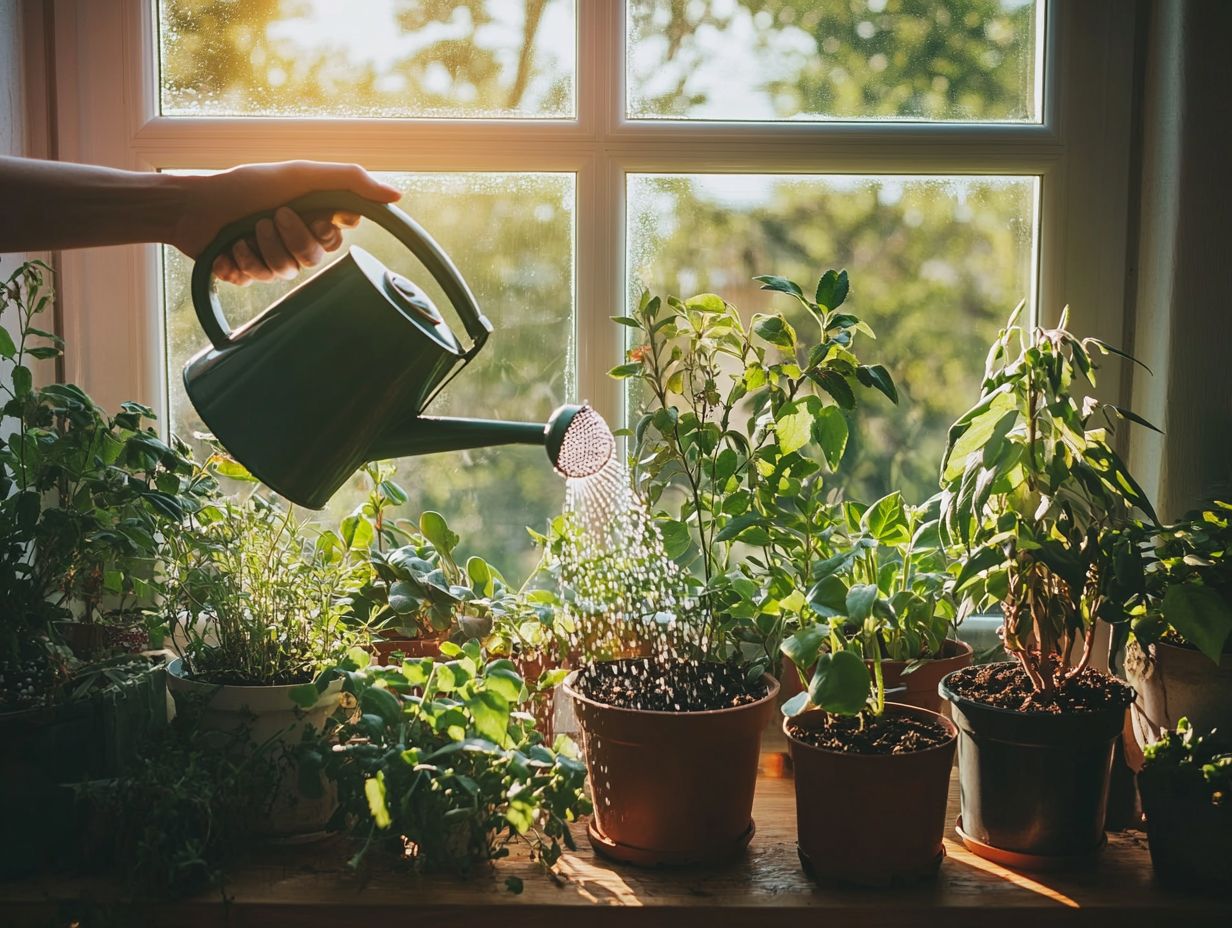
- Proper watering is crucial for the health of indoor plants, as it affects their growth, development, and overall appearance.
- Signs of underwatering and overwatering can manifest similarly. Understanding these signs and adjusting watering practices can help maintain plant health.
- Factors like light, temperature, and humidity impact indoor plant watering needs. It’s important to consider these factors when determining how much and how often to water.
Understanding Indoor Plant Watering
Understanding indoor plant watering is essential for keeping your houseplants in peak condition. It s all about striking that delicate balance of water quality, soil moisture, and the unique needs of each plant species.
Whether you re nurturing succulents, Peace Lilies, or Ficus benjamina, knowing when and how to deliver the right amount of water profoundly influences their growth and health.
Consider factors like humidity, room temperature, and pot size. These elements significantly impact how often and how much water your indoor plants require. By mastering watering, you can cultivate a flourishing environment for your green companions.
Importance of Proper Watering
Proper watering is crucial for your indoor plants. It significantly affects their growth, health, and ability to fight off pests and diseases.
If you re not careful, overwatering can lead to root rot a condition that undermines the plant s ability to absorb nutrients and water, jeopardizing its overall health. Drainage holes in pots are your allies, allowing excess water to escape and ensuring that roots remain healthy.
For example, succulents thrive on a less-is-more approach to watering, needing dry conditions between drinks. The Dracaena marginata prefers a balanced watering routine that avoids soggy soil. Understanding your houseplants specific needs can make a remarkable difference in maintaining their lush appearance and vibrant growth.
Signs of Underwatering and Overwatering
Recognizing the signs of underwatering and overwatering is crucial for your plant care routine. Both scenarios can significantly impact the health of your indoor plants.
By paying attention to these indicators, you’ll be better equipped to maintain a thriving indoor garden.
Identifying Signs and Symptoms
Identifying the signs and symptoms of underwatering and overwatering can transform the life of your houseplants. When your plants face these challenges, their growth can stall dramatically or, in the worst cases, lead to their untimely demise.
Underwatering typically reveals itself through dropped leaves, a crispy texture, and faded color. Meanwhile, overwatering tends to show up as yellowing leaves, root rot, and an overall mushy appearance.
To accurately assess the health of your plants, evaluate the soil moisture levels. A simple test, like sticking your finger into the soil up to the second knuckle, can help determine whether it’s time to water.
Understanding factors that affect growth, such as humidity, is crucial. Optimal levels can significantly enhance a plant’s ability to absorb moisture. By keeping an eye on these elements, you can create and maintain the perfect environment for your greenery to thrive.
Factors Affecting Watering Needs
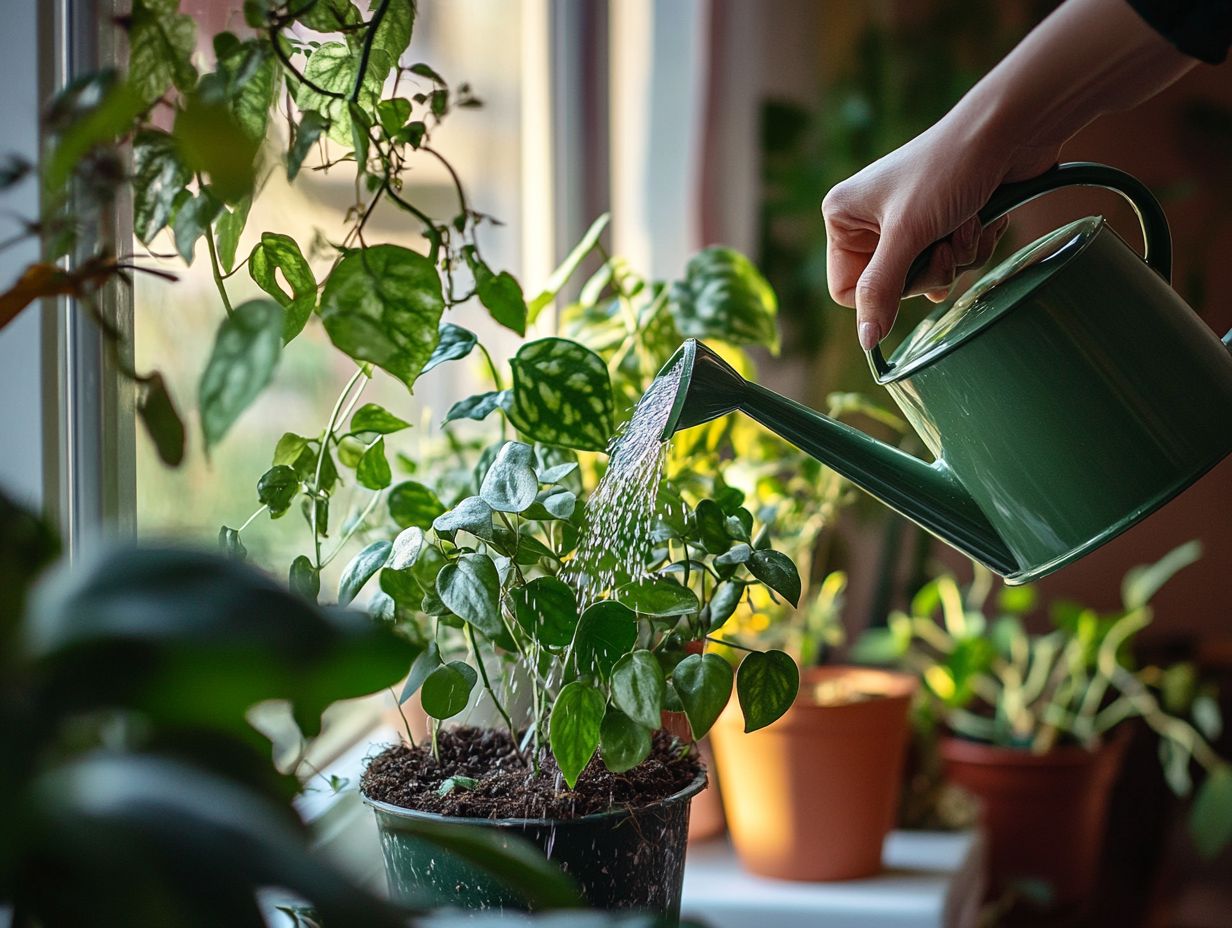
Many factors influence the watering needs of your indoor plants. Key aspects include light exposure, room temperature, humidity levels, and the unique soil moisture requirements of various houseplants.
By paying attention to these elements, you ensure your green companions thrive.
Light, Temperature, and Humidity
Light, temperature, and humidity play a crucial role in your plant’s watering needs. These factors directly impact growth.
In low light conditions, your plant photosynthesizes less, leading to slower growth and reduced water uptake. In bright indirect light, the plant s metabolism speeds up, requiring more frequent watering.
Temperature changes can also affect watering. Warm environments dry out soil faster, so monitor moisture levels closely.
To maintain humidity, consider using trays filled with water or misting your plants during dry seasons.
Strategically grouping your plants can increase ambient humidity and contribute to their health.
Best Practices for Watering Indoor Plants
Adopting best practices for watering significantly enhances your plants’ health and longevity. This ensures they get the right frequency and amount of water to thrive.
Frequency and Amount of Water
Finding the right watering frequency and amount is essential for optimal soil moisture. This fosters healthy growth.
Understanding each plant’s needs helps tailor your watering schedule. For instance, succulents need less frequent watering, while tropical varieties prefer consistently damp soil.
Seasonal changes also affect watering. As warmer months arrive, your plants may need more water; in winter, some may enter a dormant phase and require less care.
Observing humidity levels and your plant’s growth stage offers insights into the best watering practices.
Watering Techniques and Tools
Using effective watering techniques and tools elevates your plant care. This ensures your plants receive adequate hydration without the risk of overwatering or underwatering.
Consider bottom watering, where pots soak up moisture from the base. This approach reduces the chances of soil saturation.
A moisture meter is a tool that measures soil moisture levels and can be a valuable asset. It provides insights into soil humidity and guides your watering decisions.
Ensure your pots have proper drainage holes to prevent stagnant water. This avoids issues like root rot. By combining these strategies, nurturing healthy plants can be a rewarding and enjoyable experience!
Common Mistakes to Avoid

Avoiding common pitfalls, such as overwatering or underwatering, is essential for your indoor plants’ health. This helps them thrive in the long run.
Overwatering and Underwatering
Overwatering and underwatering are two critical challenges you must navigate as an indoor plant owner. Both issues can severely impact plant health, so awareness is key.
Recognizing the symptoms can truly make a difference. Typically, overwatering presents itself through yellowing leaves, a soggy feel in the soil, and root rot that may come with unpleasant odors. In contrast, underwatering reveals itself with droopy leaves, brittle stems, and dry, cracked soil.
If you find yourself dealing with an overwatered plant, the first step is to water less and ensure proper drainage. For those poor underwatered plants, a thorough soaking followed by regular monitoring is just what they need.
Preventative measures can help. Use pots with drainage holes and keep a consistent watering schedule. By paying attention to these signs, you can create a thriving indoor garden that flourishes beautifully.
Troubleshooting Watering Issues
Troubleshooting watering issues for your indoor plants is crucial for preserving their health and preventing lasting damage. Understanding the specific needs of each plant will empower you to provide the best care they require.
Regularly assessing your watering routine ensures that your plants thrive, allowing them to flourish in their indoor environment.
Addressing Common Problems
Addressing common issues related to watering indoor plants can greatly enhance their health and promote robust growth.
By recognizing the signs of improper hydration like drooping leaves, yellowing foliage, or stunted growth you can take proactive measures to address these concerns. Establishing a regular care routine allows you to monitor soil moisture levels and ensure your plants receive the perfect amount of water.
Consider utilizing a moisture meter to accurately assess the soil’s dryness before watering, or create a personalized schedule that caters to each plant’s unique needs and environment. By fine-tuning your watering habits based on these observations, you can implement the best watering techniques for indoor plants and cultivate a thriving indoor garden that flourishes with vitality and vibrancy.
Your Top Questions About Indoor Plant Care
1. How often should I water my indoor plants in soil?
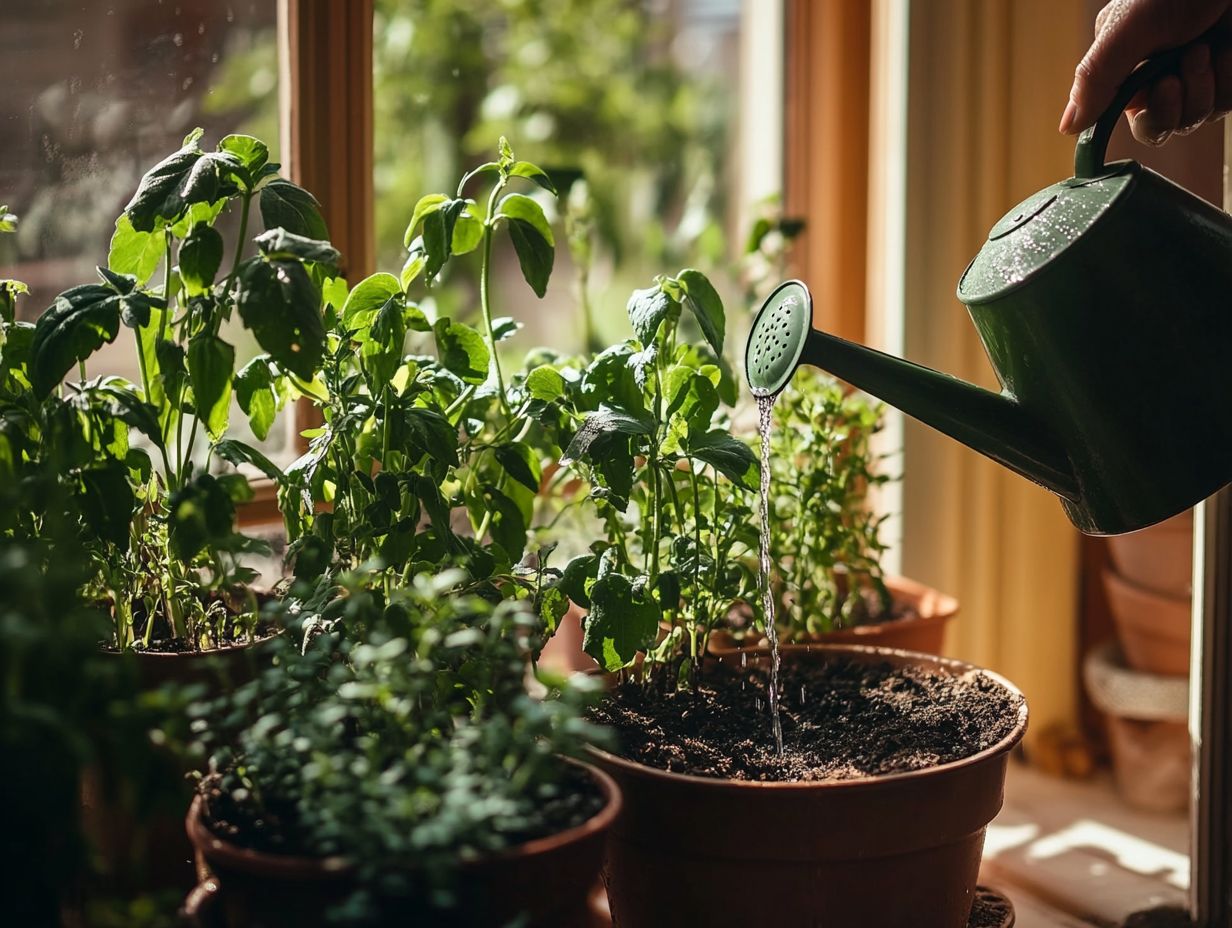
The frequency of watering your indoor plants in soil depends on several factors, such as the type of plant, its size, and the environment it is in. As a general rule, most indoor plants need to be watered once or twice a week.
2. How do I know if my indoor plant needs watering?
You can check if your indoor plant needs watering by feeling the top inch of the soil. If it feels dry to the touch, it’s time to water the plant. Alternatively, you can also use a moisture meter to accurately determine the moisture level of the soil.
3. Should I water my indoor plants in soil from the top or bottom?
It is recommended to water your indoor plants from the top, allowing the water to drain through the bottom. This ensures that the entire root system is evenly watered and prevents any potential root rot from over-saturation.
4. Can I use tap water to water my indoor plants in soil?
Tap water can be safe for most indoor plants, but it’s important to be aware of the quality of your tap water. If your tap water is high in minerals, it can cause build-up in the soil and harm your plants. Consider using filtered or distilled water for sensitive plants.
5. How much water should I give my indoor plants in soil?
The amount of water your indoor plants in soil need varies based on their size and type. A general rule of thumb is to water until you see water draining out of the bottom of the pot. This ensures that the plant is thoroughly hydrated.
6. Can I overwater my indoor plants in soil?
Yes, it is possible to overwater your indoor plants in soil. Overwatering can cause root rot and other fungal diseases, leading to the death of your plant. It’s important to always check the moisture level of the soil before watering and adjust the frequency based on the plant’s needs.
Start observing your plants today and adjust your watering routine to keep them thriving!

